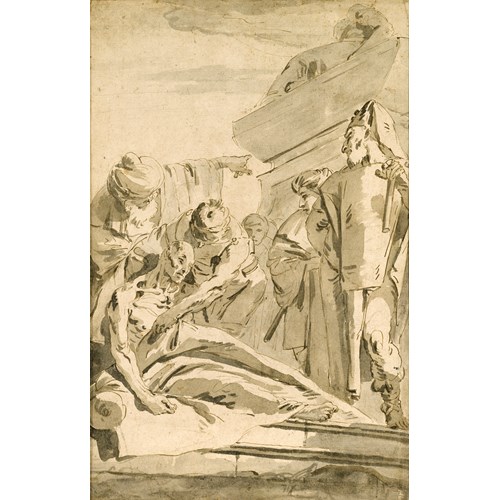Marketplace
Villagers Rejoice at the Return of a Cavalier
Joost Cornelisz Droochsloot
Villagers Rejoice at the Return of a Cavalier
Epoque 1600-1750, 17th century
Origine The Netherlands
Medium Oil on panel
Dimension 53.2 x 73.2 cm (21 x 28⁷/₈ inches)
In this village scene, a lively mass of figures flood the street to welcome the return of a cavalier. In the right-hand foreground, individual villagers are dramatically poised, while to their left, a seated elderly couple look on, and out of the town gate in the distance, a father and son arrive to witness the excitement. The cavalier in the centre of the composition, the cause of the commotion, is distinguished from the shadowy crowd that jostle around him by his red coat and brilliant white horse. The scene shimmers with activity, and the contrasting light, animated figures and free brushwork enhance the energetic feel of the painting.
Joost Cornelisz. Droochsloot painted many village scenes similar to this work, although often they are more heavily populated. His Winter in a Dutch Town in the Hermitage, St. Petersburg is one such example; while stylistically similar, Villagers Rejoice at the Return of a Cavalier demonstrates a more Italianate influence, indicated by the golden light, the clothes of the peasants, and the architectural component. This stands in contrast with the Dutch content of the Hermitage work and its notably more prosperous surroundings, manifested in the conical towers and dress of the townsfolk.
Droochsloot’s skill as an artist is evident in the considerable detail of his paintings, from the landscape and buildings, to the individual expressions of his figures, which, as in the present painting, imbue his work with charm and character. His representation of figures in expressive poses, typical of his village scenes, enlivens the painting and intrigues the viewer. Compositionally, the artist’s placement of converging buildings and other major landmarks on either side of the action, a common technique of the time, creates a sense of space and distance as the eye follows the receding lines back into the picture.
Droochsloot’s early works reflect the influence of Pieter Brueghel the Elder (c.1525-1569) and Pieter Brueghel the Younger (c.1564-1637/38), as well as David Vinckboons (1576-1629). An important and prolific painter, draughtsman and printmaker, Vinckboons’ oeuvre contains various peasant scenes. In Distribution of Loaves to the Poor, a heaving crowd of peasants vie for the limited supply of bread that is being distributed. The rush of movement within the painting created by the dynamic postures of the individuals, and the keen attention to detail lavished on them, offers a clear example of the influence that Vinckboons exerted on Droochsloot’s peasant scenes and his artistic representation of figures.
Droochsloot was active in Utrecht from 1616 to 1660 and was admitted to the Guild of St. Luke in 1616, serving as the Guild’s dean from 1623 to 1624. Apart from his village scenes, he was also a painter of genre picture, moral allegories and biblical narratives, and he continued the tradition of Flemish landscape painting. He was the teacher of his son, Cornelis Droochsloot (1630-1673) and Jacob Duck (1600-1660).
Joost Cornelisz. Droochsloot painted many village scenes similar to this work, although often they are more heavily populated. His Winter in a Dutch Town in the Hermitage, St. Petersburg is one such example; while stylistically similar, Villagers Rejoice at the Return of a Cavalier demonstrates a more Italianate influence, indicated by the golden light, the clothes of the peasants, and the architectural component. This stands in contrast with the Dutch content of the Hermitage work and its notably more prosperous surroundings, manifested in the conical towers and dress of the townsfolk.
Droochsloot’s skill as an artist is evident in the considerable detail of his paintings, from the landscape and buildings, to the individual expressions of his figures, which, as in the present painting, imbue his work with charm and character. His representation of figures in expressive poses, typical of his village scenes, enlivens the painting and intrigues the viewer. Compositionally, the artist’s placement of converging buildings and other major landmarks on either side of the action, a common technique of the time, creates a sense of space and distance as the eye follows the receding lines back into the picture.
Droochsloot’s early works reflect the influence of Pieter Brueghel the Elder (c.1525-1569) and Pieter Brueghel the Younger (c.1564-1637/38), as well as David Vinckboons (1576-1629). An important and prolific painter, draughtsman and printmaker, Vinckboons’ oeuvre contains various peasant scenes. In Distribution of Loaves to the Poor, a heaving crowd of peasants vie for the limited supply of bread that is being distributed. The rush of movement within the painting created by the dynamic postures of the individuals, and the keen attention to detail lavished on them, offers a clear example of the influence that Vinckboons exerted on Droochsloot’s peasant scenes and his artistic representation of figures.
Droochsloot was active in Utrecht from 1616 to 1660 and was admitted to the Guild of St. Luke in 1616, serving as the Guild’s dean from 1623 to 1624. Apart from his village scenes, he was also a painter of genre picture, moral allegories and biblical narratives, and he continued the tradition of Flemish landscape painting. He was the teacher of his son, Cornelis Droochsloot (1630-1673) and Jacob Duck (1600-1660).
Epoque: 1600-1750, 17th century
Origine: The Netherlands
Medium: Oil on panel
Signature: With monogram ‘J.V. DS’ (lower left).
Dimension: 53.2 x 73.2 cm (21 x 28⁷/₈ inches)
Plus d'œuvres d'art de la Galerie









